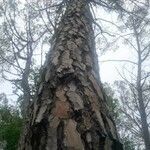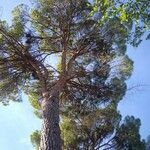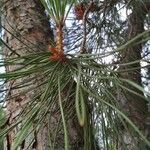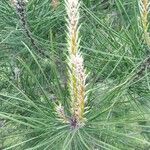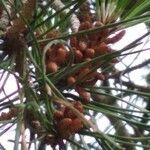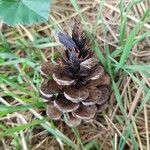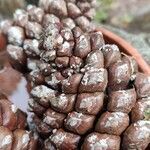Tree to 20 m tall, with a broad, rounded crown. Bark red-grey, persistent, broken by deep longitudinal fissures. Resting buds narrowly ovoid, 6-20 mm long, pale brown, non-resinous, with fringed, apically reflexed, persistent scales. Leaves glossy, dark green, finely toothed, 10-15 cm long, in bundles of 2, with 2 external or sometimes medial resin canals; basal sheath 8-12 mm long. Female cones sessile, pendulous, ovoid, symmetrical, glossy brown, 10-15 cm long, persisting on tree for several years after maturity; scales oblong, lacking a terminal spine. Seeds with a rudimentary wing less than 1 mm long.
A flat topped tree. It can reach 27 m tall. The branches radiate upwards like the ribs of an umbrella. The bark is light brown and cracks into long flat plates. The leaves are needles which grow in pairs. They are dark green and long. The male flowers are golden. The female flowers are green. The cones are large and heavy and globe shaped. One cones contains about 100 seeds. Cones take about 3 years to ripen. The nuts or seeds are eaten.
Up to 30 m, parasol-shaped; bark greyish-brown, flaking to leave reddish-orange patches. Twigs glabrous, greyish-green, becoming brown. Buds not resinous; scales white-fringed. Leaves 100-200 x 1-5-2 mm, in pairs, acute; resin-canals submarginal. Cone 8-14 x 10 cm, shining, brown; apophysis weakly pyramidal. Seed 15-20 x 7-11 mm; wing less than 1 mm, caducous; husk hard.
Monoecious, umbrella-shaped tree to 30 m. Leaves needle-like, 50-150 mm long, in bundles of 2, thick and rigid. Cones usually solitary, ovoid-subglobose, scales thick, radially ribbed, blunt; seeds edible.
